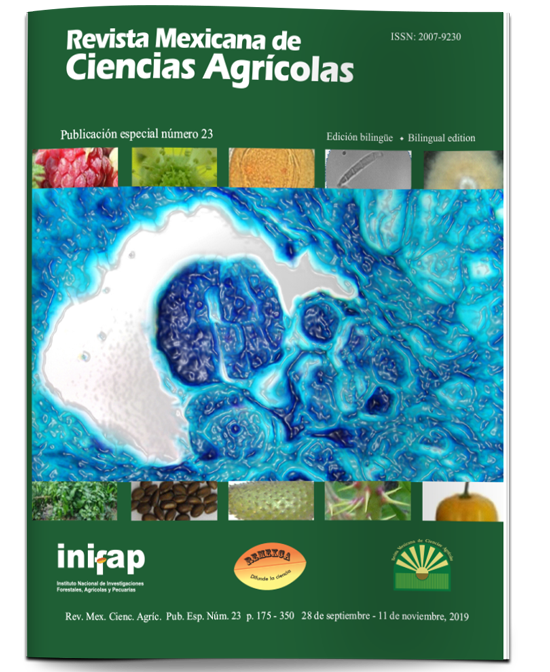Accumulation of cold hours for cranberry production in Nayarit, Mexico
DOI:
https://doi.org/10.29312/remexca.v0i23.2019Keywords:
agroclimatology, cold hours, temperatureAbstract
The climate is a determining factor of the yield and quality in agricultural production systems. The objective of this work was to quantify the cumulative cold hours in Nayarit and to use this information as an agroclimatic indicator in the regionalization to produce cranberry (Vaccinium corymbosum L.). The research used data from the network of agrometeorological stations in Nayarit, which consists of 38 automated stations that collected fifteen-minute data of 11 variables. With minimum temperature records, cold hours were calculated, which were organized by month and accumulation per year. Using a geographic information system, the distribution of annual cold hours (HFA) was cartographically represented, with interpolation and organization of the results in four phases (<299, 300-399, 400-499 and 500-699). For each HFA class, the area was quantified in each of the 20 municipalities. Finally, the precision of the interpolation model against a database outside the main data set was evaluated. The results show that only in 27.4% of the state surface accumulate more than 300 HFA which is the minimum requirement for cranberry. The thermal conditions for cranberry are mainly located in the center and south of the state, highlighting the municipalities of Compostela, Xalisco, Tepic, Santa María del Oro, Jala, La Yesca and Ixtlan del Río that represent 81.6% of the apt surface. The results are a precedent for the accumulation of cold hours in Nayarit and serve as a planning tool for decision makers, technicians and producers interested in the cultivation of cranberry.
Downloads
Downloads
Published
How to Cite
Issue
Section
License
The authors who publish in Revista Mexicana de Ciencias Agrícolas accept the following conditions:
In accordance with copyright laws, Revista Mexicana de Ciencias Agrícolas recognizes and respects the authors’ moral right and ownership of property rights which will be transferred to the journal for dissemination in open access. Invariably, all the authors have to sign a letter of transfer of property rights and of originality of the article to Instituto Nacional de Investigaciones Forestales, Agrícolas y Pecuarias (INIFAP) [National Institute of Forestry, Agricultural and Livestock Research]. The author(s) must pay a fee for the reception of articles before proceeding to editorial review.
All the texts published by Revista Mexicana de Ciencias Agrícolas —with no exception— are distributed under a Creative Commons License Attribution-NonCommercial 4.0 International (CC BY-NC 4.0), which allows third parties to use the publication as long as the work’s authorship and its first publication in this journal are mentioned.
The author(s) can enter into independent and additional contractual agreements for the nonexclusive distribution of the version of the article published in Revista Mexicana de Ciencias Agrícolas (for example include it into an institutional repository or publish it in a book) as long as it is clearly and explicitly indicated that the work was published for the first time in Revista Mexicana de Ciencias Agrícolas.
For all the above, the authors shall send the Letter-transfer of Property Rights for the first publication duly filled in and signed by the author(s). This form must be sent as a PDF file to: revista_atm@yahoo.com.mx; cienciasagricola@inifap.gob.mx; remexca2017@gmail.
This work is licensed under a Creative Commons Attribution-Noncommercial 4.0 International license.



